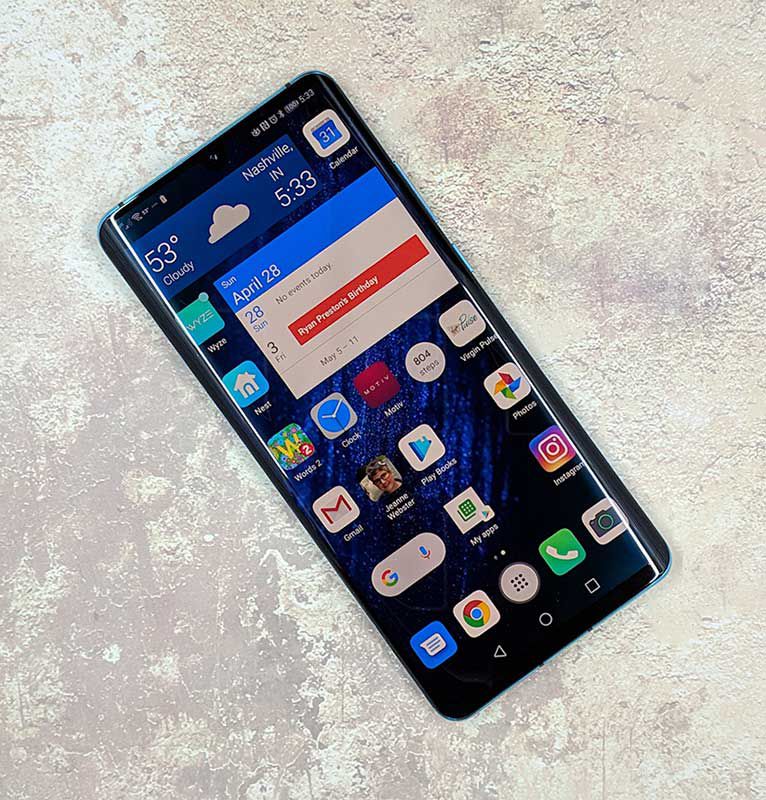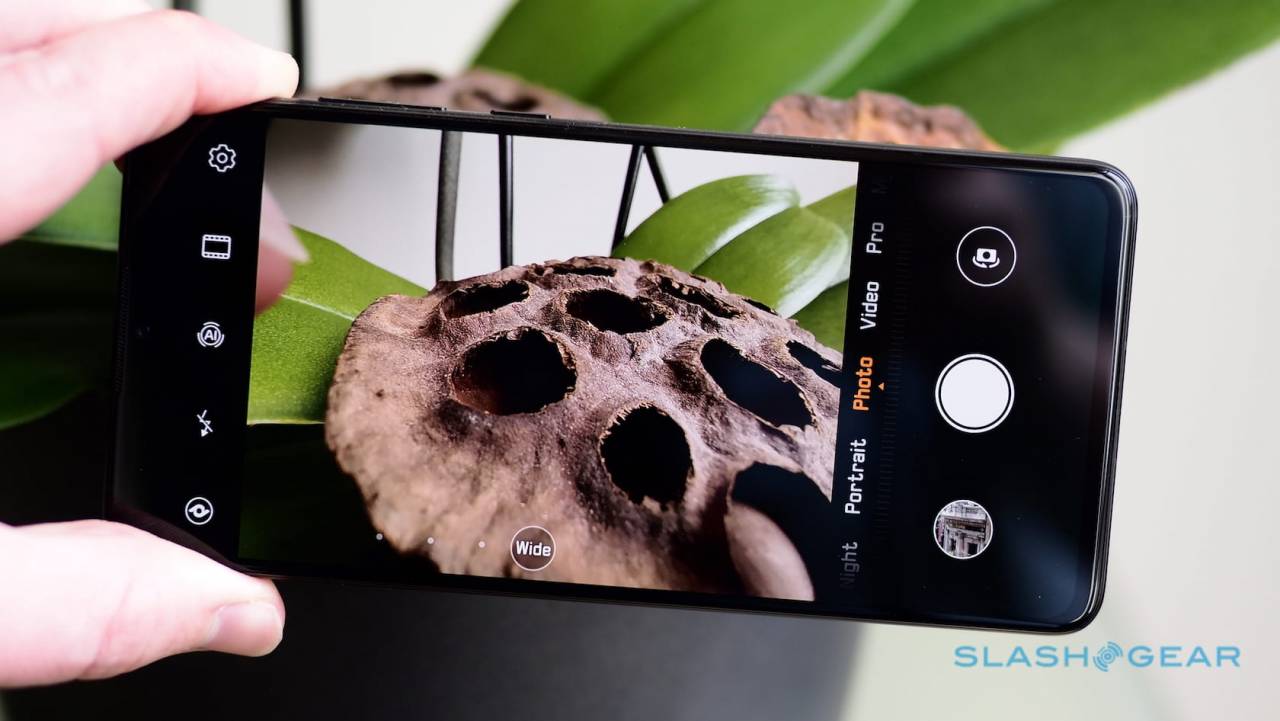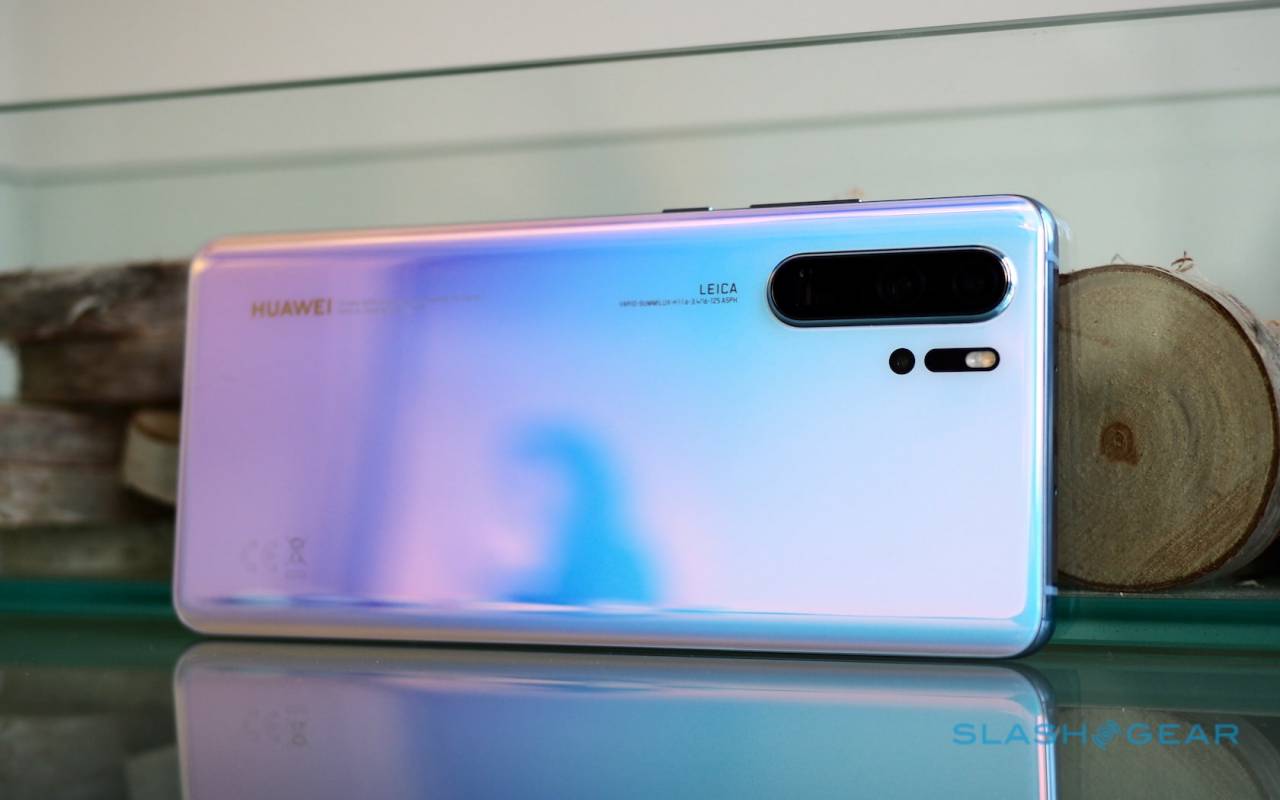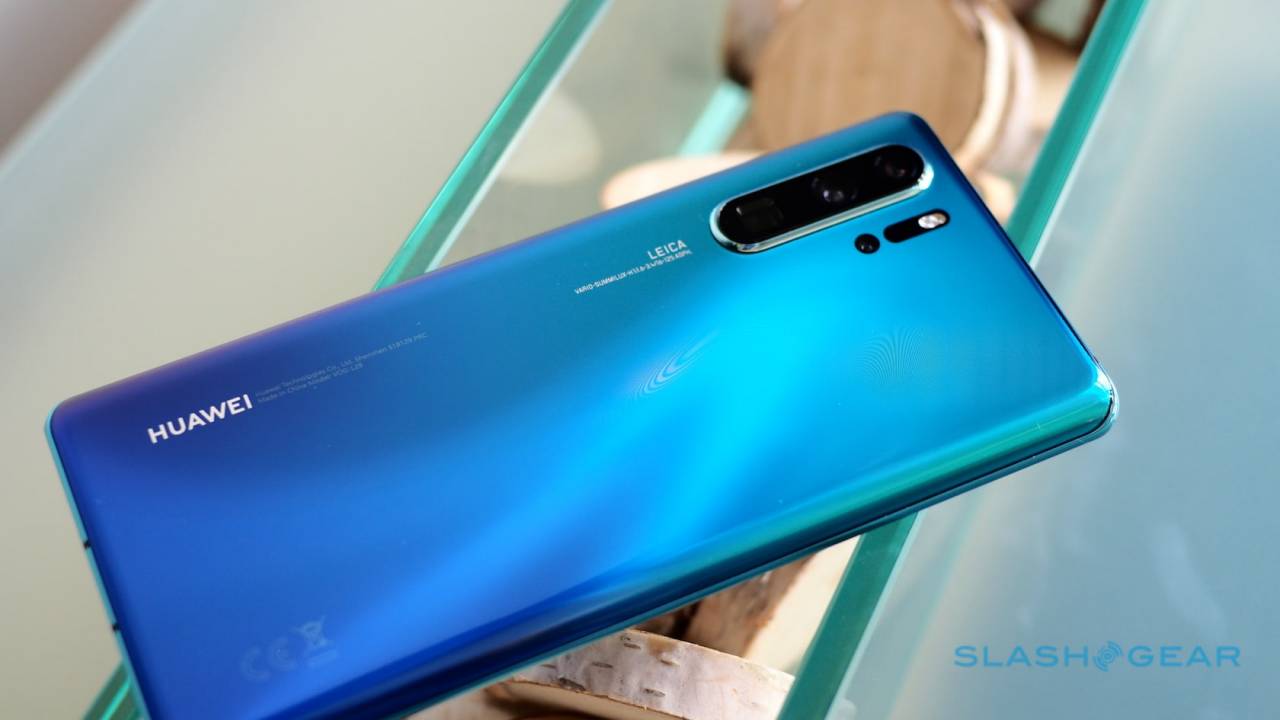
It's great for those group shots but you should always use the main camera if possible, as it produces much better images. The ultra-wide mode is a great option to have, but the main camera will generally produce far better photos. But the best feature of P30 Pro's camera isn't its versatility or even its zoom.
It's the absolutely stunning low-light photos it can produce. Thanks to Huawei's new, RYYB SuperSpectrum sensor which the company says captures 40 percent more light, the P30 Pro takes great night and indoors photos like it's no big deal.
Huawei P30 Pro review: Smartphone photography, redefined
It's important to point out that I'm not talking about Night Mode, which requires you to keep the camera steady for five or more seconds. With the P30 Pro, you can just point and shoot in default mode, and you'll get usable photos even in totally impossible conditions. This was taken in so-dark-you're-bumping-into-things conditions.
The P30 Pro still managed to capture the city lights from neighboring islands, as well as individual stars. And this is not Night Mode; this is on default camera settings. In fact, at moments I wished Huawei would tone this down a little. In certain situations, I'd get a firework of colors from a totally serene night scene; sometimes, certain areas of the photo were just unnaturally bright. This photo is amazingly bright, but honestly, the scene didn't look like that at all in real life. Those colorful lights in the distance were barely visible. I've made some comparisons against the Mate 20 Pro and the iPhone X, but they're pretty pointless.
With every other phone in default shooting mode , the photos above would be a few smears on a slab of blackness. It's not a difference in quality, really — normal phones' cameras simply don't work in these conditions. The separate Night Mode still exists, and it's still preferable for taking a photo of something that's very still, like a building. The Mate 20 Pro has the Night Mode as well, but my review unit sometimes ruined the photos with horrible artifacts; I did not have this issue with the P30 Pro. The P30 Pro's Night Mode is useful for taking photos of buildings, but most of the time you can just shoot in default mode.
So far, the P30 Pro was impressive. But I needed to compare it with the best and newest phones available. Ray's verdict is that "the P30 Pro just narrowly edges out the Pixel 3 XL with sharper and slightly brighter night shots that also have less image noise. In the example below, the P30 Pro's photo is brighter and sharper, but there's some loss of detail compared to the Pixel's photo — check out the text on the road sign. Separate low-light shooting modes take 5 or more seconds on all of the phones that have them. But the P30 Pro can shoot in darkness on default settings. And then It needs to be said that Huawei is cheating a little here.
When you take a photo in low-light conditions, the phone will automatically prompt you to hold it steady until it sharpens the photo. This is akin to a mini-Night mode — it takes far less time, but it does take some time, sometimes as long as 3 seconds. Note that you don't have to do it; you can simply point, shoot and immediately pocket your phone, but the results won't be as good.
In the example below, all of the photos were taken on default settings. Yes, the iPhone is laughably bad compared to the other three, and only Samsung manages to get close to Huawei's amazingly sharp and bright photo. What else? In typical Huawei fashion, portrait photos are a bit soft, and bokeh is imperfect.
But I've been taking portrait photos with various Huawei flagships for years, and my subjective experience is that overall, they turn out pretty great. It's not so much a matter of photo quality but of simply looking at the photo and liking it; the iPhone X my primary phone and various other phones I've tested over the years just weren't as good. Huawei also made damn sure it has every single feature its competitors have. The P30 Pro has a Super Macro mode which turns on automatically when you point the camera at something very close to it , a panorama mode, a time-lapse mode, even an underwater mode.
And if that's not enough, you can play with the options yourself in Pro mode. Some Huawei-typical quirks remain.
Huawei unveils new P30 Pro with two extra colour schemes and Android 10
HDR is present as a separate mode, buried in the camera's many settings, and you can't make it persistent on the default camera mode though the phone's AI does use it when it deems you worthy. And the phone does tend to overexpose images, so HDR would be handy in many situations. Selfies are great, even though the P30 Pro doesn't have a front-facing, depth-sensing camera.
A Huawei representative told me during the phone's presentation that the company has worked on this, and it's true: while still not perfect, the Portrait a. And those 32 megapixels will give you a lot of detail to zoom in, if you really want to. The P30 pro takes videos in up to 4K 30fps resolution, and can also take fps slow-motion videos.
It's cool that you can actually zoom up to 10x while shooting video in p mode, but good luck catching anything that's moving. In the video below, I've switched from default mode, to 5x zoom, to 10x zoom. Huawei says the camera's low-light magic translates to video as well, but the effect is not nearly as pronounced as with photos. Overall, the P30 Pro camera is great at pretty much everything, while at the same time bringing two features that no other phone has: 5x zoom and amazingly bright night photos.
The P30 Pro performs just as good as the Mate 20 Pro after all, it's powered by the same chip , which means wonderfully.
Huawei spying allegations: What you need to know about the Chinese tech giant
The Geekbench 4 scores the P30 Pro a little higher at 3, single core score and 9, multi-core score but honestly, it's not noticeable in actual usage. In a word, the P30 Pro is fast. The battery life was stellar. I've fully charged the P30 Pro once; exactly two days of heavy usage later, battery was at 48 percent.
Latest Stories
I connected it several times to my MacBook Pro to transfer images after that, and it'd charge a little during that time. Long story short, I'm still running on that one charge, five days later. The phone comes with Huawei's super-fast charger in the box, which should get you a 70 percent charge in half an hour I've simply never had the chance to test that.
I'd need more time with the P30 pro to properly judge its battery life, but first impressions are that it's up there with the best of them. One thing to note: By default, the P30 Pro is in "power saving" mode. If you want to unlock its full performance, you'll have to go to battery settings and choose "performance mode. Huawei's EMUI 9. It can be hopelessly confusing, and it still asks you to dive into Huawei's ecosystem of services such as Huawei Cloud which I refuse to do too many times.
Some changes that Huawei made are hard to explain. The software development and hacker communities residing within the major technology firms already have informal inter-firm efforts to monitor embedded operating systems and applications for potential malware. To date, they've done a very good job overall of discovering major security exploits and malware, but we can improve this by formalizing how this is done by having our government form and fund organizations with our allies -- as part of overall international treaty negotiations -- with the express effort of increasing due diligence in analysis and monitoring of software that runs on consumer electronics.
The efforts to date have only covered "In-band" types of exploits and malware. This needs to continue, but we have to go deeper. The real concern would be "out-of-band" exploits and malware that would not be discovered within applications or operating systems, but in the components, such as firmware or hard-coded routines within the semiconductors themselves like a baseband communications chip that would not be detected as a high-level process.
So far, no such state-sponsored malware or an exploit has ever been detected in a semiconductor component originating from China, or, at least, such a discovery has never been validated. All we have received so far is an accusation from a reporter at Bloomberg that certain SuperMicro server systems had a chip that was intercepting and forwarding network traffic from data centers of 30 American corporations, including Apple.
That has so far been proven to be categorically false by SuperMicro , as well as Apple and Amazon. The only comparable out-of-band exploits that have been discovered are the Spectre and Meltdown bugs in Intel, AMD, and ARM processors, which are categorized as unintentional but exploitable architectural flaws and common issues related to modern microprocessor design -- and they have nothing to do with China.
Oh, and the most significant discovered out-of-band exploit prior to those two? Also Intel in origin. Also: In rapid onslaught, Chinese phone makers take control. So, should we be concerned about out-of-band exploits and potential malware in a society that is increasing its use of electronic devices in every aspect of our lives? Should we worry that China is plotting some master plan to Hoover all our data and penetrate our government?
Should we worry that China is plotting some master plan to Hoover all our data and penetrate our government and corporations using undetectable malware embedded in the fundamental components found in consumer electronics manufactured in that country? There's a chance it could happen, and we should be vigilant and take our best efforts to monitor that it isn't happening, but we can't preoccupy ourselves with this.
Let American consumers decide which products they want to buy. Legislation that prevents competition is not only stupid and unproductive but also puts our citizens at a disadvantage by not allowing them to purchase inexpensive products that other countries can freely and easily access. Should you be allowed to buy Chinese brands of phones in the US? Is Congress and the Trump administration interfering with the fundamental principles of capitalism? Talk Back and Let Me Know.
- cell location reviews Oppo;
- 超歓迎 5個セット 越前漆器 [A]乱引半月盆 溜パール尺3寸 [ 39 x x cm ] 料亭 旅館 和食器 飲食店 業務用 特集!
- Despite ban, you can still buy Huawei phones in the US. Here's how - CNET.
- Should anyone buy a Huawei or Honor phone?;
- cellphone spy program for Galaxy Note 7.
Chinese manufacturers fuel global smartphone sales. Worldwide smartphone sales climbed 9.
- how i locate a cellphone Huawei P30 Pro;
- Three Huawei phones are banned in Taiwan, but not for the reason that you're thinking?
- What is it?.
- what is the best phone locate program LG G7.
- cell Facebook tracking Google Pixel 3.
Elite Chinese hackers target board directors at some of the world's largest firms. The APT 10 hacking group has struck again, this time using a watering hole attack to compromise the National Foreign Trade Council website and gather sensitive data about its directors. Mars up close: NASA takes the biggest interplanetary selfie ever. By registering, you agree to the Terms of Use and acknowledge the data practices outlined in the Privacy Policy. You may unsubscribe from these newsletters at any time.
You may unsubscribe at any time. By signing up, you agree to receive the selected newsletter s which you may unsubscribe from at any time. You also agree to the Terms of Use and acknowledge the data collection and usage practices outlined in our Privacy Policy.

Microsoft pauses Edge releases amid coronavirus outbreak. Microsoft follows in Google's footsteps, who similarly paused Chrome updates earlier this week. Hackers first began exploiting the bug in August last year. Fintech company Finastra hit by ransomware. Company shuts down services but promises to have everything up by Monday. Free resource to help parents keep kids safe online as schools move to eLearning.
 Phone snooping tool Huawei P30 Pro
Phone snooping tool Huawei P30 Pro
 Phone snooping tool Huawei P30 Pro
Phone snooping tool Huawei P30 Pro
 Phone snooping tool Huawei P30 Pro
Phone snooping tool Huawei P30 Pro
 Phone snooping tool Huawei P30 Pro
Phone snooping tool Huawei P30 Pro
 Phone snooping tool Huawei P30 Pro
Phone snooping tool Huawei P30 Pro
 Phone snooping tool Huawei P30 Pro
Phone snooping tool Huawei P30 Pro
 Phone snooping tool Huawei P30 Pro
Phone snooping tool Huawei P30 Pro
Related phone snooping tool Huawei P30 Pro
Copyright 2020 - All Right Reserved